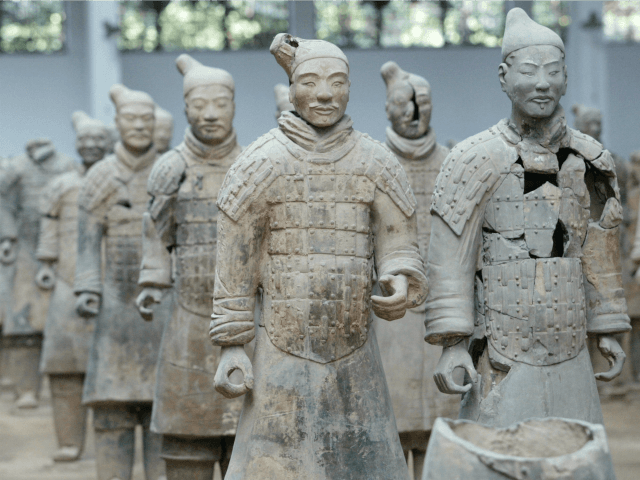China’s Shaanxi Cultural Heritage Promotion Center is demanding the United States “severely punish” a man who allegedly defaced an ancient terracotta warrior statue while it was on display at the Franklin Institute museum in Philadelphia.
The accused, Michael Rohana, is 24. The terracotta warrior, considered one of the most important archaeological discoveries in China, is about 2,200 years old and worth an estimated $4.5 million.
According to court documents, Rohana was at the Franklin Institute for an “ugly sweater” party on December 21 when he wandered into the terracotta warrior exhibit, took a few selfies alongside the statue, and then apparently broke off its thumb and pocketed it as a souvenir. After museum staff reported the thumb missing, the FBI tracked Rohana down to his home in Delaware. He admitted the theft and retrieved the broken thumb from his desk drawer when an FBI agent interviewed him.
CNN notes that one of the other attendees at the ugly sweater party stated that Rohana was “bragging about sneaking into the exhibit and having a thumb from one of the warriors” during the ride home to Delaware.
Rohana was charged with theft and concealment of artwork from a museum and the interstate transportation of stolen property. He has been released on bail.
The Franklin Institute described the vandalism as a “deplorable act” and said it was possible because a security contractor did not follow “standard closing procedures” to secure the exhibit on the night of the ugly sweater party.
The New York Times reviews the history of the Terracotta Army, which is a very important historical artifact for China, not least because it was created by the emperor who the entire nation of China is essentially named after. The Times explains:
The terracotta warriors were built for the tomb of Qin Shi Huang, China’s first emperor. He united much of the country under the short-lived Qin dynasty, which is generally considered the origin of the name “China.”
Thousands of the life-size statues, each unique, were buried with models of horses, chariots and weapons after the emperor’s death in 210 B.C. The tomb and its contents were not discovered until farmers unearthed some of them in 1974.
Many of the statues are on display at the Mausoleum of the First Qin Emperor in Xi’an, China, where they are lined up in vast pits. Many others remain buried. Others still have been removed from the pits and are sent for temporary exhibitions in museums around the world.
National Geographic has video of the astonishing Terracotta Army dig site, with vast regiments of clay infantry and cavalry lined up in the hallways of the mausoleum, which was effectively a scale-model recreation of the entire region. “Scale model” in this sense does not mean miniatures like a model train set; the tomb complex is now believed to cover almost 38 square miles altogether.
One of the reasons it is so large is that many of the workers who created the mausoleum are buried within it. According to various accounts, this was either an honor rendered unto those who died working on the project, an effort to provide Emperor Qin Shihuang with a suitable workforce when he reached the afterlife, or a highly effective strategy for keeping the location of the tomb secret for over two millennia by killing everyone who knew where it was. Furthermore, a great many people died in the wars over Qin’s succession, and the authorities apparently decided to take advantage of the huge mausoleum the emperor had provided for them.
According to contemporaneous documents, over 700,000 laborers worked on the tomb for over 35 years. To this day, no one knows exactly how large the Terracotta Army was when work was halted. The clay troops have followed the standard closing procedures of 209 B.C. to the letter, and have proven an effective security force as the actual tomb of the First Emperor remains undiscovered. Archaeologists have been reluctant to disturb the site by digging deeper to find it, although advanced modern technology continues to reveal remarkable details and baffling mysteries about the complex.
“We ask that the U.S. severely punish the perpetrator. We have lodged a serious protest with them,” Shaanxi Cultural Heritage Promotion Center Wu Haiyun said on Monday. He also condemned the “careless” Franklin Institute for allowing the vandalism, promised that experts from China would be sent to evaluate the damage, and sought compensation.

COMMENTS
Please let us know if you're having issues with commenting.